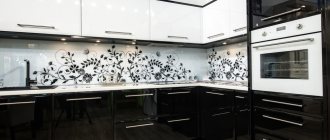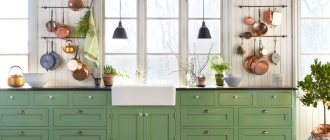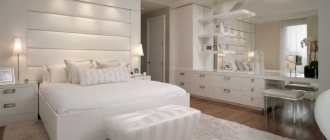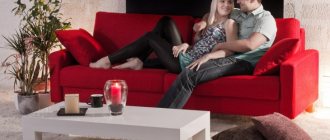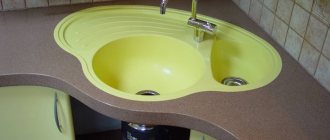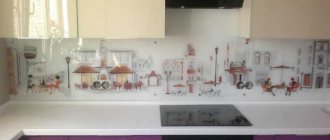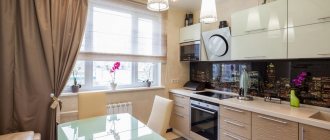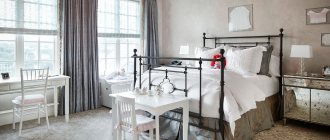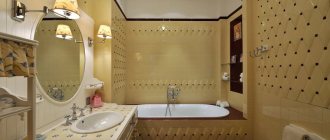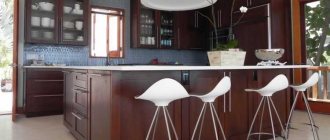The meaning of colors in design
The impression created by the interior largely depends on the color scheme used. It affects the visual perception of the entire environment. By applying design techniques in practice, you can create the impression of spaciousness, distract attention from the asymmetry of the room, and highlight the necessary accents.
The impression created by the interior depends on the color scheme used
If the color palette is chosen incorrectly, the overall perception of the layout and interior may be disrupted. The tone of the furniture should be in harmony with the shade of the walls, kitchen apron, floor, and ceiling.
The choice of the general range should be based on your preferences in design. There are several main options:
- Cheerful, cheerful interior.
- Balanced and balanced environment.
- Calm and cozy space.
Balanced and balanced environment
Factors influencing the choice of kitchen color
Modern kitchen
As you know, the design of a room depends on its:
- destinations – bedroom, living room;
- style;
- character – calm or spectacular, calming or uplifting.
It is necessary to follow the following design rules regarding how to choose a kitchen color and optimally combine this color with others:
- Use no more than two or three colors, otherwise the main idea of the design will be lost. There may be a little more shades. For example, using a base color and its shades of neutral tones. Another option is a combination of two basic and several transitional tones between them.
- The floor and ceiling cannot be made in the same color, this will cause disproportion in the space of the room. The higher you go to the ceiling, the lighter the colors.
- When decorating a large room, it is necessary to “dilute” light shades with bright accents. For example, the colors chosen for the kitchen set are completely different than for the countertop and apron. If the furniture is of discreet shades, then you need to place emphasis on other elements (curtains, walls, tablecloths). If the facades are bright colors, the walls cannot have an active color scheme.
- When using more than one shade, only one tone is dominant.
- As in any other room, colors should be combined. Contrasting shades should be used carefully; the result can be aggressive or tasteless.
- The decor plays the role of color accents; it is recommended to use it in intense colors.
When determining the optimal color scheme for the kitchen, you need to start with the furniture. If the set is in bright colors, then the surrounding elements are decorated in calm, neutral colors and vice versa.
Bright set
Where to start the project?
The choice of color combinations in the kitchen interior should be based on the following important factors:
- room size;
- ceiling height;
- shape of the room;
- is the kitchen combined with other rooms;
- availability of natural light;
- age and temperament of family members;
- number and location of windows;
- Which side of the world are the windows facing;
- how much time family members will spend here;
- how family members want the kitchen to look;
- style of the kitchen, as well as the entire apartment.
Cheerful cheerful interior
Additionally, the necessary financial investments in remodeling an existing kitchen or decorating an existing one must be taken into account and calculated.
Cold and warm tones
The entire range of tones is divided into warm and cold. The choice of one or another is made based on the planned effect.
Light and cool shades have a calming effect. These include:
- grey;
- blue;
- pale green.
White color is not very practical
For rooms with insufficient lighting, warm colors are the best choice. Such tones will create a cozy atmosphere conducive to friendly communication.
Warm ones include:
- light pink;
- red;
- yellow;
- brick.
Beige
Selecting headset color
The color of the headset is largely decisive. By choosing it correctly, you can correctly place accents, complement and complete the look of the kitchen, created using the rest of the interior elements. The colors themselves can be universal, warm or cold, moderately saturated, brightly saturated.
Universal colors
Several colors are generally considered universal. Each of them is used in a variety of styles and has a number of properties:
- White is considered suitable for a small kitchen, and most often several shades of white are used in combination with the colors of creme brulee, champagne, and baked milk. White is also combined with metallic accents.
- Gray is perfect as a discreet background that emphasizes the whiteness of the facade. Cool gray goes well with warm beige.
- Black is increasingly being used in shades such as anthracite or graphite rather than jet black. For combinations with white, matte facades are gaining popularity, although glossy ones used to be in fashion.
Warm moderately rich
These are shades that create a sunny, bright environment. The most popular of them:
- beige,
- woody,
- cappuccino,
- sand,
- Ivory.
Cold, moderately rich
Cool shades are used to create a feeling of freshness and calm. These include:
- blue,
- olive,
- lilac,
- pistachio,
- champagne
Small kitchen: there will be no easy ways in design
Arranging a small room is always a difficult task. We need to combine practicality and home comfort at the same time.
Dark set: pros and cons
The choice of a dark furniture set in this case is rarely justified. Dark is noble and effective, but will act overwhelming, depriving the space of comfort and visually making it smaller.
Stylish kitchen design
Kitchen combined with living room
If the living room and kitchen are combined, then the style and design of these rooms, which differ in functionality, should be common. At the same time, visual separation is allowed by the use of different materials, types of finishes, and shades.
Overcoming limitations
The smaller your kitchen, the fewer options you have for implementing design techniques.
The best choice for a modest-sized room would be a pastel palette with a predominance of cold tones.
Classic version
Lacquered surfaces will help to visually add free space:
- furniture facades;
- glossy stretch ceiling;
- Kitchen backsplash tiles with a glossy sheen.
Advice In cases where the design requires the introduction of dark colors into the interior, you can use a combination of several tones. White and black combinations, graphite with a milky tone can show themselves well. This will give originality to the interior and add sophistication to it.
White room color with bright elements
What color to choose for rooms with special conditions
If for a spacious and bright room, especially in a private house, choosing the colors of facades for the kitchen and decoration is usually not difficult, then for small, dark, and irregularly shaped rooms, choosing a palette can be difficult. The traditional solution is to prefer a light color scheme, but this does not always satisfy the owners. Therefore, the harmonious and comfortable arrangement of a kitchen with various shortcomings is considered a special skill among designers. You can use their ideas yourself – within your own budget.
Small kitchen
A particularly small kitchen poses a particular challenge in interior design. There is not enough space here for a full-fledged work area, not to mention a dining room. Nevertheless, a small area does not take away the functionality of the room, and the owners are forced to work with just such a room. Taking into account the properties of different shades, different techniques are chosen for such a room:
- An exceptionally light, even sparkling palette is a great way to visually enlarge a space. Metallic shine, like mirror surfaces, reflects light, which contributes to the visual expansion of the room. In this case, only individual taste will help you choose a more accurate color for your kitchen units. It can be classic bronze, glamorous gold, or industrial chrome.
The next photo shows a small kitchen in shiny metallic tones.
- The standard solution for a small room remains a neutral palette - white, milky, cream, light beige. They do not clutter up the space, so they allow you to feel comfortable in any room.
- An interesting option is the use of transparent furniture. The facades of the kitchen unit can be of any kind. For example, the dining room is made of glass and/or plastic, and the furniture in the work area is in a bright, rich shade of fuchsia or a sunny lemon tone. On a snow-white background or using transparent details, with a mirrored or inconspicuous neutral apron, such colors will seem appropriate and harmonious.
Colors of kitchen units in the northern room
For a northern, and therefore poorly lit, kitchen, it is recommended to select light shades. But they should not be dull: lemon, orange, yellow and even red can be called optimal. Of course, the richer the tone, the more calm and neutral the background should be.
But it all depends on the area of the room and its geometry:
- It is advisable to paint narrow, elongated rooms in light colors, especially if there are windows facing north. Here, bright colors are not always appropriate, since the distance between the facades and the opposite wall will be small, which means that the shade can visually “clutter” the space.
- The color of a kitchen facade that is square, but dark due to the placement of the room, can be quite bright. But an orange or lemon shade on the walls and in the window frame will look much more interesting, which will create the illusion of bright sunlight penetrating the room through the double-glazed windows.
The photo below shows a small kitchen in a yellow and milky palette.
- When choosing any color for a “northern” kitchen, it is important to provide the room with enough light. Even dark surfaces can be used so that they do not look oppressive and bulky: just install additional light sources. This can be lighting along the entire contour of the furniture, spotlights and sconces.
Kitchen apron: wide choice
An opportunity to enliven a small kitchen is provided by an apron of unusual colors, located near the sink and along the work surfaces. It can be the same tone as the vertical or horizontal surfaces of the kitchen furniture. Or it may be different, bringing originality to the design of the room.
The choice of palette for the apron is quite large, each tone has its own advantages:
- black adds style and is often combined with a white set;
- brown - goes well with almost the entire palette, adds coziness;
- gray – universal, noble, can be presented as an imitation of marble or granite chips;
- white is a classic, ideal for any decor.
White is often combined with a black set
Countertop: quality or style?
There are no strict rules for choosing in this case. Most often, a neutral palette is selected: gray, beige, white, black.
The imitation stone looks interesting. This option will suit any style.
Main requirements:
- good quality material;
- high performance properties;
- compatibility with apron, facades.
Brown - goes well with almost the entire palette
Curtains for windows
Window decoration is essential in any interior. Thick, good-quality curtains will be inappropriate.
It is best to choose light, thin fabrics that match the rest of the interior. They do not burden the perception of space.
Gray color is universal
Curtains can be plain or contain prints that match the style of the room. Bright colors are rarely chosen; usually preference is given to a calm color scheme, white.
Basic combination techniques
When the kitchen is done in one tone, then everything is simple. According to Itten's circle rule, we select 2 – 4 adjacent colors and tint them, adding white or black to diversify the range. The only limitation is that you cannot use less than 3 shades in the interior so that the kitchen does not look boring.
The color scheme of the walls automatically takes a dominant position, so it is better to paint them in a single color, but lighter than the floor, to bring the situation down to earth.
In a multi-colored interior, on the contrary, you cannot use more than 5-6 shades so as not to break the integrity of the interior, otherwise the kitchen will cause a feeling of loss and be full of color. Regarding finding the right color scheme, there are a lot of them, but it is better to stick to the classics. Let’s choose three of the simplest, but no less popular.
Related article: Kitchen studio: 5 layout options/design features
Dyad
Triad
Quadriad
At first glance, the color scheme gives rise to doubts, but the second main task is to intelligently distribute the color in space. The main color of the walls can be shaded or highlighted regardless of the percentage. You can paint adjacent walls in different colors, visually dividing the room.
It can be diluted with another shade, but the additional color should be up to 30% of the total mass.
That is, if we have 70 ml of a base color, then we can add up to 30 ml of another color until we obtain the desired shade. The shade of the diluent must correspond to the scale obtained from the Itten circle.
Color for the kitchen: flour of choice
When choosing the main palette for the kitchen, there are many factors to consider. Including compliance with the style and overall design of the house. It is important that the selected shade does not irritate.
Orange: dynamic
Dynamic and juicy, orange can give a boost of energy. It stimulates creativity, lifts mood, improves appetite, brings cheerfulness, and promotes sincere conversations. Most suitable for cheerful, creative individuals.
White is a classic, ideal for any decor
A lot of orange becomes boring if you see it every day. It is not often chosen by balanced people who value the tranquility of their home.
One of the best combinations of orange is with white.
Bright and always invigorating
Green: freshness, calm
Bright green, absorbing all the richness of spring meadows. It brings a touch of freshness and revitalization.
Bright green, absorbing all the richness of spring meadows
Green is considered to be:
- stimulates brain function;
- gives peace of mind;
- calms;
- relaxes;
- promotes relaxation.
Green, reminiscent of shades of grass and leaves, gives the impression of a clean, environmentally friendly interior. Especially when combined with white, yellow and other companion colors.
Green stimulates brain function
Blue: romanticism
It is a rich color with many tones. Soft blue – associated with the sky and sea. Deep - helps to concentrate, gives impetus to the development of creativity.
Tip Blue goes well with white, natural unpainted wood, and beige.
Red: activity
Active, dynamic people, who are always full of ideas and a thirst for activity, often prefer red. In addition, in design it has a strong association with romantic relationships and love. It also improves your mood, looks unusual, bright.
Red - for active and dynamic people
Despite all the advantages, shades of red should be used with caution so that the interior does not turn out to be irritating. An excess of exciting red can provoke nervousness and aggression. And total red will be too intrusive.
Advice The best combinations are given by red with white and black.
A color scheme
Almost all interiors are based on an organic combination of several shades. The selected colors should fit well with each other and be pleasant for those living in the house.
In the style of minimalism
Monochrome interior
Maintaining the entire interior in one color means using several different degrees of saturation. It can be almost any color. Greens, blues or other shades will look interesting.
Close tones
Close colors are those that are adjacent on the color wheel. These include, for example, red, orange, yellow. Using only one or two bright colors, and the rest are blurry, pastels, you can make the interior warm and cozy.
Classic style in green
Contrasting combinations
Spectacular contrasts have already become classics. This is for example:
- white with black;
- brown with green;
- red and white and others.
How to choose a kitchen color?
Today, manufacturers of furniture and finishing materials offer a huge palette of colors. Sometimes it is very difficult to find the optimal solution. And in order to somehow concretize the idea of the color in which you want to see your kitchen, you need to take into account some features: color properties and combination of shades, kitchen lighting, room parameters, interior style, the influence of color on a person’s mood. Let's look at these features in more detail later in the article.
What you need to know about colors and shades
Cold and warm
All colors and their shades can be divided into two types – warm and cold.
Red, yellow, orange and their combinations are “warm” shades. And they look positive, bright, exciting, radiating energy.
Blue, violet, blue colors are considered “cold” shades. And they are associated with calm, relaxation and some restraint.
Within each color, warmer and cooler shades are distinguished. For example, green with a yellowish tint is considered warm and revitalizing, while green with blue belongs to the group of cold ones, it refreshes and soothes.
Warm, intense colors appear closer, so they make a space appear smaller. And light colors are perceived as distant, receding and visually increase the space.
In the kitchen interior, cold and warm shades can be used either individually or in combination with each other. A well-chosen color scheme will influence not only a person’s mood, but also his well-being.
Achromatic colors
In addition to warm and cold shades, there are achromatic or neutral colors - white, black and all shades of gray. Each color individually will look boring, faceless or depressing in the kitchen interior. But, if neutral colors are combined with warm or cold shades, the kitchen interior will become brighter, more sophisticated and original.
Style dictates the rules
There are many restrictions and selection criteria. First of all, it is compliance with a certain style. Each of the directions has its own main features.
| Style | Predominant tones | Note |
| High tech | Metal surfaces are complemented by gray and white | |
| Minimalism | White solo or a combination of black with white and gray | |
| Scandinavian | White | |
| Pop Art | Bright | Neon colors are acceptable |
| Kitsch | Bright | Neon colors are acceptable |
| Shabby chic | Pastel | |
| Provence | Pastel | Complemented with lavender |
| Country | Pastel | |
| Classical | Natural and pastel |
Simple tips will help you avoid mistakes when decorating and create a beautiful interior.
Retro style
Recommendations:
- Do not use several bright shades at the same time;
- It’s best to limit yourself to three primary colors;
- if bright wallpaper is chosen, then it is advisable to make furniture facades in calm colors;
- It is better to use trendy bright colors for wallpaper, rather than for facades, since it will be much easier to replace wallpaper later;
- if family members spend a lot of time in the kitchen, then it is best to choose neutral colors for decoration;
- for older families, light colors are preferable, as bright colors can be tiring;
- pink and gray, combined together, reduce appetite;
- horizontal contrasting stripes on the walls allow you to “expand” the space;
- the most universal are calm natural tones;
- it is easier to add dynamism to a calm interior using bright accessories than to try to dim the brightness of the main tone colors;
- vertical stripes – “raise” the ceiling;
- It is better to choose a neutral color as the main color for the headset - gray or white.
VIDEO: Beautiful interiors in different colors
What color to choose for the kitchen?
Creating a good mood in the kitchen
